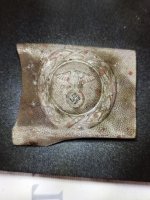cti4sw
Bronze Member
- Jul 2, 2012
- 1,555
- 919
- 🥇 Banner finds
- 1
- Detector(s) used
- Minelab Equinox 600, Garrett AT Pro, Pro Pointer
- Primary Interest:
- Relic Hunting
For example, some links are twisted vs. straight. When did that style/method become popular?
Are there specific characteristics that can differentiate one era of smithing from another?
What's a good indication of machine-made chains, other than uniformity?
And what might indicate hand-forged chain vs. machine-made chain?
Thanks to any who reply.
Are there specific characteristics that can differentiate one era of smithing from another?
What's a good indication of machine-made chains, other than uniformity?
And what might indicate hand-forged chain vs. machine-made chain?
Thanks to any who reply.







